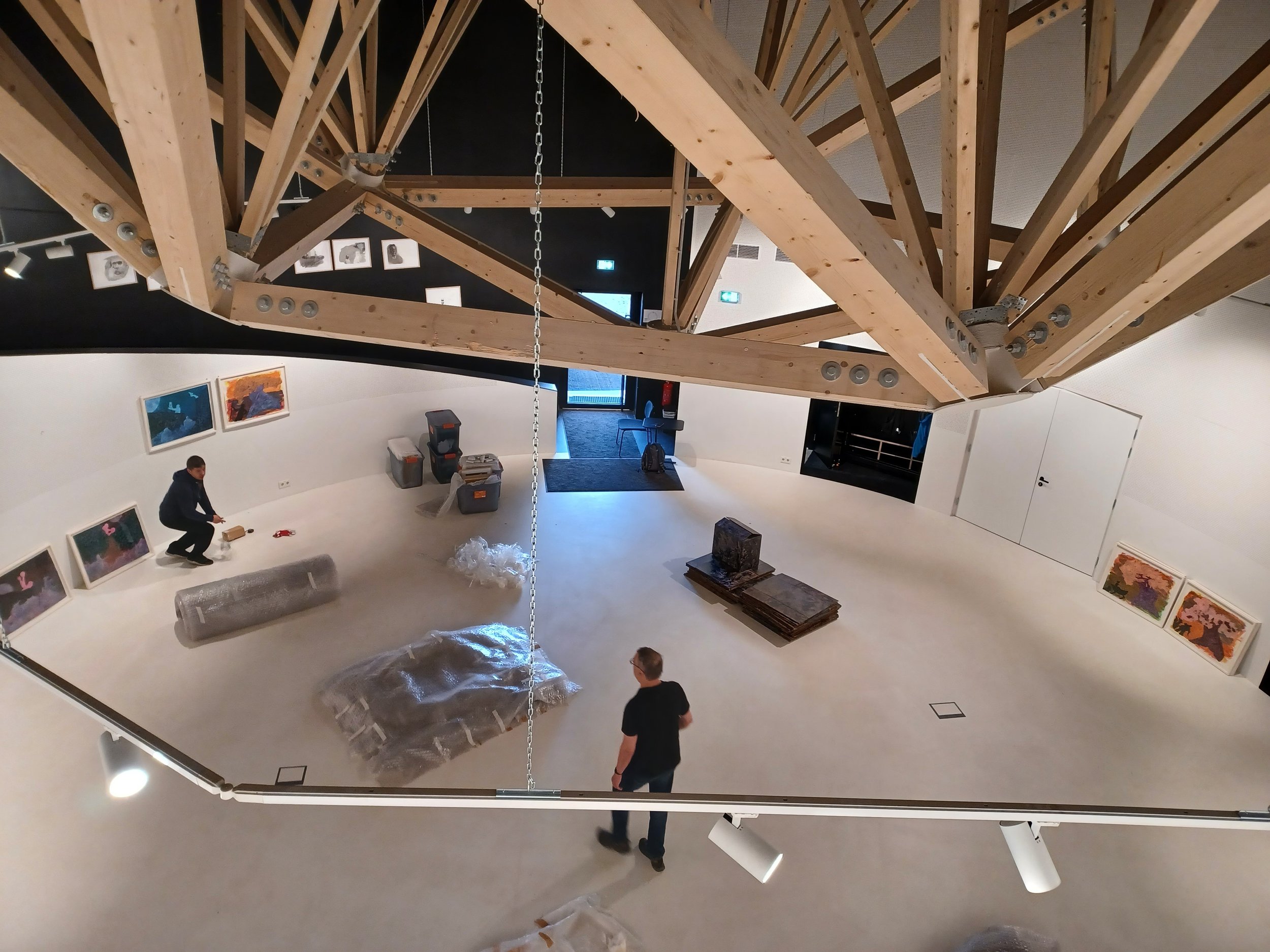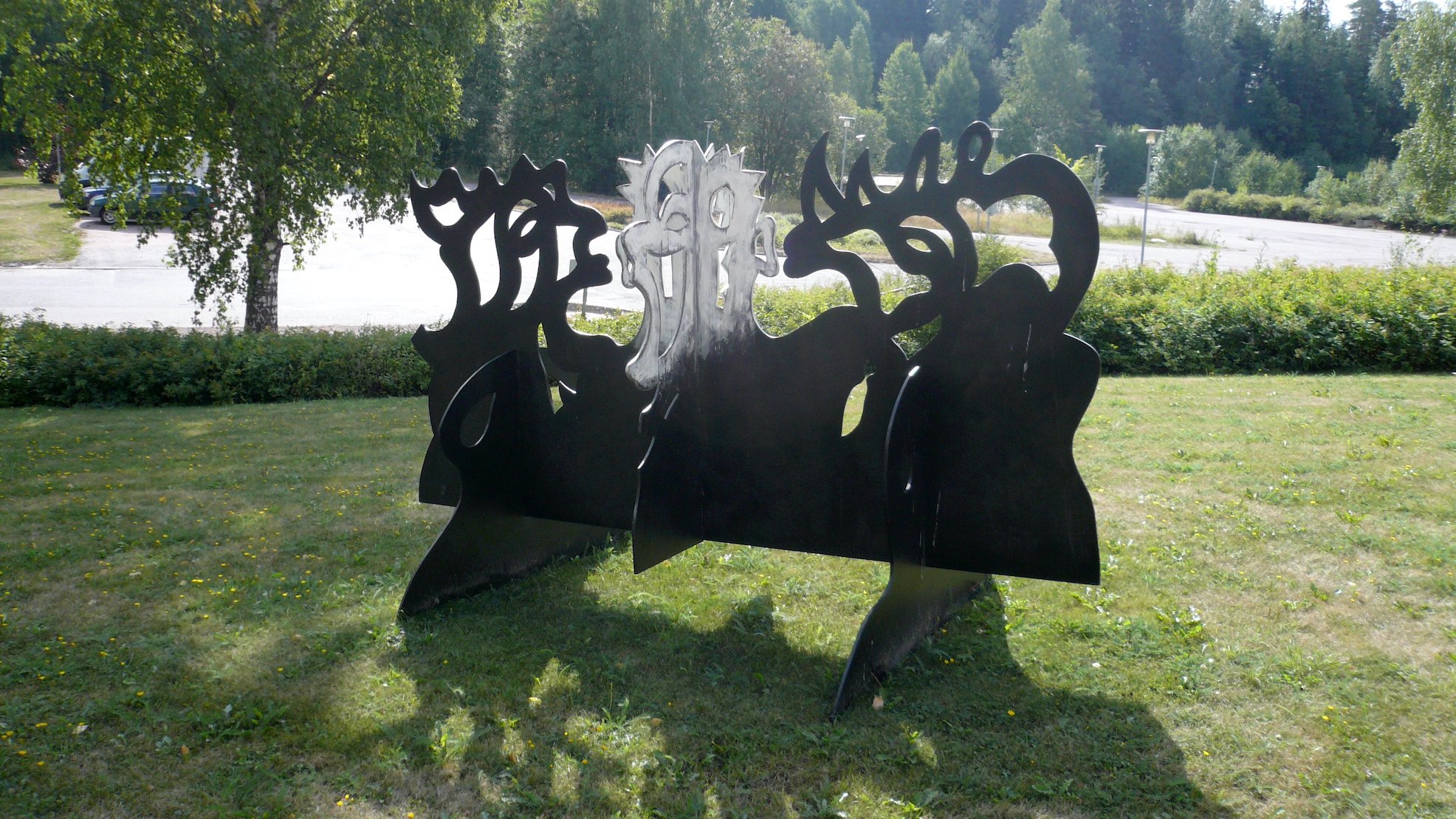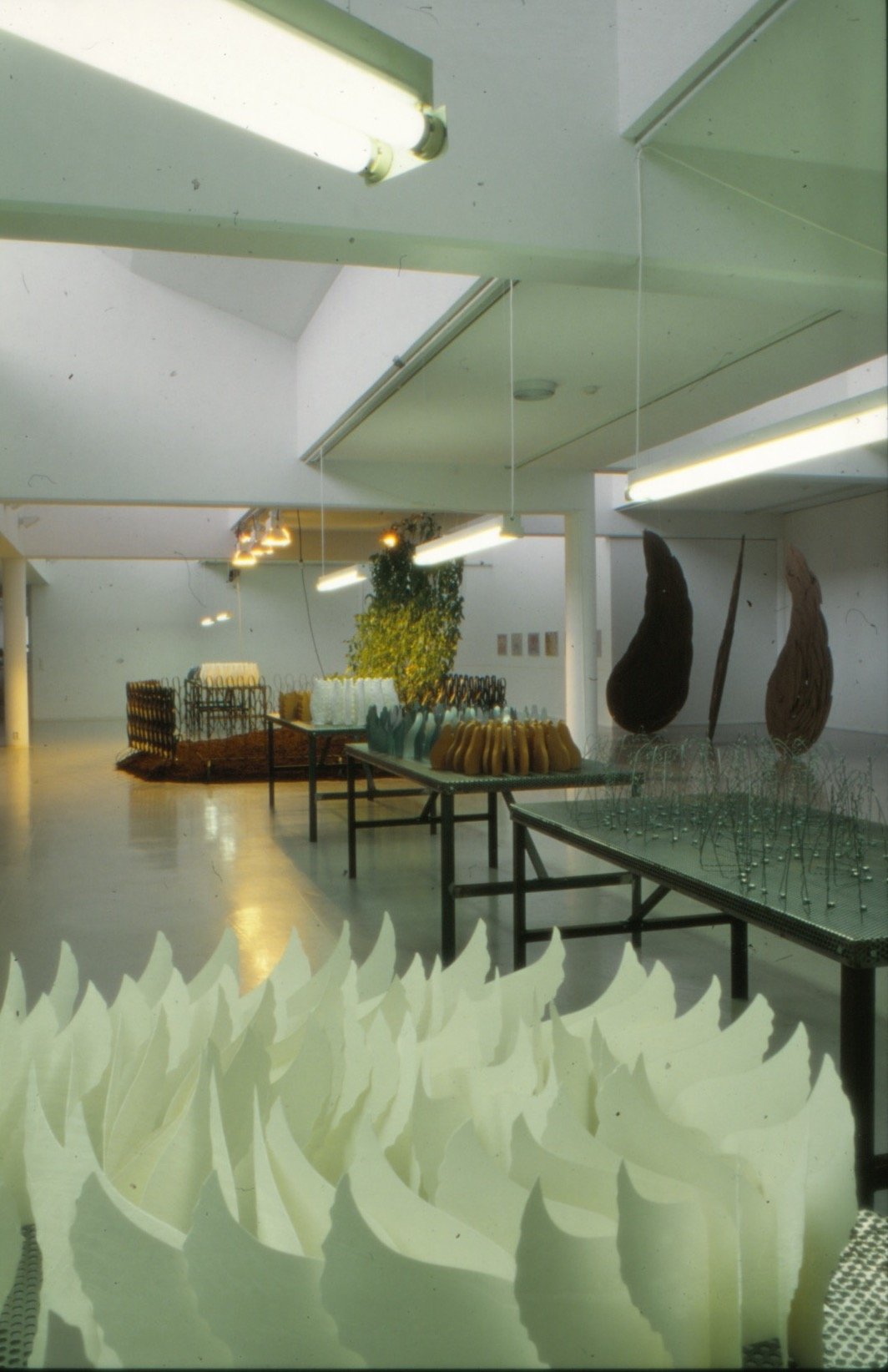2024 Contemporary Art Gallery of Viimsi Artium, Estonia
2022 Kuntsi Museum of Modern Art, Vaasa, Finland
2010 Kerava Museum of Modern Art (Sinkka), Kerava, Finland
2003 Mikkeli Museum of Modern Art, Mikkeli
1999 Gallen -Kallela Museum, Espoo, Finland
1994 Retretti, Savonlinna, Finland
1993 Kunsthalle, Helsinki, Finland
1987 Espoon Cathedral, Espoo, Finland
Contemporary Art Gallery of Viimsi Artium, Estonia
House of Moments 15.5.–15.7.2024
o Art is a manual for existing in the world, the content of which is determined by the predestined connection of imagination and knowledge.
o A work of art is a message that becomes meaningful only when it is interpreted by an observer.
o A moment is the culmination of time. It is the event horizon of time, beyond which there is no return to the past, no access to the future.
o House of Moments is based on the idea of a world built on experiences and events stored in memory and the narratives they comprise. Stories are the offspring of time and place. If time vanishes, so do the stories.
o My artistic work is always connected to social engagement. It means taking a stand within the visual and verbal information field that surrounds us. My artworks are also part of my life story, dives into the unpredictable mind. The purpose and content of my works emerge during the creative process. I trust the experience created by the moment and the subconscious. My artworks are the archaeology of my mind. For me, art is always a process – not a product.
o The paintings, drawings and the installation featured in the exhibition are directly or indirectly related to my project 1095 days – Notes from the Draughtman's Diary, created between 2016 and 2019, which was based on the everyday information of the Helsingin Sanomat newspaper. Every day for three years, I randomly selected a press photo and transformed it into a new drawing - the mental landscape of the artist, the story of the moment. This collection of drawings forms an image archive that continues to serve as a constant source of inspiration and material for new works. The large-scale mixed media works on plywood, the acrylic paintings on paper and the installations assembled from everyday materials are based on the archived sketches. The intense physical processing, experimentation with various materials and reworking of surfaces are strongly present in my artworks.
o Upstairs in the Gallery a video + sound world by Antti Hakuri
Espoo 5th of March 2024 Markku Hakuri
Kuntsi Museum of Modern Art, Vaasa
The Magic Mountain 14.4–11.9.2022
The exhibition's title refers to Thomas Mann's novel The Magic Mountain. The novel represents an unreal world of isolation, where decadence, the concept of time, and illusions converge. What is your magic mountain?
Thomas Mann's novel, with its events—an isolated sanatorium dealing with questions of life and death, its inhabitants with worldviews shaped by their circumstances, the difficulty of descending from the mountain, and the relativity of time—has sparked my interest in the enigmatic magic mountain that influences everything happening in the sanatorium. The Magic Mountain became the theme of our upcoming exhibition, a metaphor for life's complexity and its representation.
Art is my magic mountain. My magic mountain is not bound to time or place. It gives me the opportunity to delve deep into the depths of the human mind or rise to the heights of imagination, to connect worlds as they often appear in dreams—everything is possible. The difficulty of descending from the mountain signifies returning to everyday reality, interrupting the work process, or completing a project. The Magic Mountain is a "structure—a tapestry," the entirety of my life with all its contents. My mountain is a dream of freedom.
The choice of an exhibition title is often quite arbitrary. The title of our exhibition could have been something entirely different. However, the topics inspired by my discussions with Jan Kenneth touched on Mann’s The Magic Mountain and motivated me to visually explore the ideological world it contains. As a clarifying example of the randomness of title selection, I had an exhibition in the early 1980s titled My Family Could Be From Africa. I have no direct connections to Africa, nor, as far as I know, does my family. The name emerged on a whim, probably while listening to traditional Zambian music. The theme expanded into exploring African imagery and color palettes. The name became a state of mind and an imagined family history and imagery.
The Magic Mountain is thus a state of mind. It is impossible for me to describe it as a concrete entity. Imagined concretely, the magic mountain is something unnatural. It could be a pile of coal, a heap of waste, or Mount Rushmore with its carved figures. It represents something created or produced by humans, something that has arisen as a result of our actions—for better or worse.
Perhaps the most important observation about my magic mountain in this context is that the more one tries to describe it, the further it recedes.
Dear viewer, this is my magic mountain. I suggest you create your own. It is as close to the truth as mine is.
Catalog / Kerava Art Museum
Pain 16.6.–29.8.2010
Pain is longing
Of all the spiritual and physical dimensions of pain, the most significant to me is longing—longing for life, longing for death, and the conflict they create. The longing to understand life—the journey between birth and death—manifests as existential anguish, the anxiety of being, and the desire to comprehend the purpose or purposelessness of existence.
Arbitrary coincidences guide the origin and development of life on our planet. This is called evolution, the choice of chance. To what extent does humanity, through its actions, influence the course of these coincidences? What possibilities do we have to organize the mystery of life into an understandable whole? The basis of our questions and reflections is the constantly changing world around us. We long to find a perspective on the world that allows us to clarify the past and the future for ourselves—the meaning of our lives. We seek answers, yet every answer generates new questions. Is our search futile? Are there no answers, or are they already contained within the questions we pose?
Ultimately, however, all that exists will be reduced to ashes and atoms. We will disappear, our planet will vanish, our solar system will be destroyed, and our galaxy will dissolve. Can the universe have a reason or purpose?
Mikkeli Art Museum
A Red Thread Runs Through My Life 4.4.–16.5.2003
We are surrounded by ideological chaos. Hunger, cruelty, and killing are the everyday reality—brothers to our well-being. Closing our eyes, staying silent, and citing busyness as an excuse have become the virtues of our time. Things are fine as long as we do not see the evil.
It is commonly believed that art is a way to organize the surrounding chaos. However, art can also challenge the systems and beliefs we have created. On the other hand, art can just as well be an escape from reality, a lie, or self-deception.
Art as a means of understanding the world is as uncertain and erratic as any other attempt to find the red thread of life.
Espoo, 21 December 2002
Gallen-Kallela Museum, Espoo / Catalog
Long live the Kalevala 13.5.–31.10.1999
Dear viewer
One’s opinion of the world depends on the observer’s perspective. The world is a mesh of events. The smallest movement – in the observer or in the world – provides a new perspective. The same things in a different way. There is no correct perspective, no correct way. The existence of numerous alternatives creates uncertainty and diversity. Rules of correctness and their strict observance breeds repetition. A tolerance of diversity and uncertainty lays the foundations for pluralism and richness of wealth. Therein also lies a dream of freedom. Art is a dream.
Kauklahti, February 3, 1999 Markku Hakuri
Alvar Aalto Museum, Jyväskylä
The Unlimited Possibilities of a Tomato-Centric Worldview 24.4.–22.5.1994
The artist sits on the terrace. He is pondering how to organize the world; in front of him, a worker, and behind him, a large window.
Thinking generates energy. The energy spreads to the window and the garden. The window warps. Growth in the garden accelerates. Within a week, the tomatoes are already bearing fruit.
Intense contemplation has driven the artist into a state of weightlessness. Without realizing it, he levitates. A miracle has occurred on the terrace. The artist only becomes aware when the air current presses him among the ripe tomatoes, and the strong scent of growth permeates his mind. He does not notice the short flight.
Espoo, 8 March 1994
Markku Hakuri
Visual Artist
Retretti, Savonlinna
1994 Perspectives
Goldfish problems
The naked artist is standing in the cave. He tries to put into words what she sees and experiences. At the same time, he understands, that every uttered word would be wrong. A mission to be a poet – but forbidden to speak.
In the cold of the cave the poet sweats. Paperwings hang soaked in water on his back. The lived-through knowledge creates a miracle on the skin of the poet: The drops of sweat are formed into transparent wings rising up to the ceiling for everyone to see creating the world.
Espoo 1st March,1994
Kunsthalle, Helsinki, Finland
From Love to Birch and Star 3rd to 25th April 1993
Birch and Star
When I talk about the subject, I must look back. I fear leafing through the pages of past years. Returning is always painful.
Naming is wonderful. In the 1980 exhibition catalog, I find the first mention of birch and star. It is a series of five works. Or six. The naming history from the same time also contains other titles: Superman Dives into the Atlantic, The Laughing Pig, The Fisherman, Memories of Scotland, The Planter, Lightning Strikes the Gooseberry Bush, The Flies Cross the Atlantic. A name is a sign. I live in the shadow of signs: My Life as a Loon, My Life is Not a Cinderella Story.
At the beginning of my art journey, I collected a stockpile of names like a poetry collection. I wrote them into a drawer.
Names are born, flourish, and die. Their temporal duration varies. One fades after a week, another resonates years later. Birch and star. Pure and earthly. Bound and free. When I’ve managed to wade back into the name stockpile of 1980, I realize my fear of history is gone. I find my life as a birch and star. Happy and confused.
Kauklahti, 25 February 1993
Markku Hakuri
ESPOO CATHEDRAL
Star Recorder 8th to 15th November 1987
When I write about making an image, I must browse through the texts of certain writers. Erno Paasilinna says: "A good writer is unreliable and immoral. They are not solidaristic. Solidarity as a general principle means committing to everything that obligates in its name, and it is very immoral." (Erno Paasilinna: Solitude and Defiance).
I have a dream. Visual artists do not belong to unions or associations, they do not exhibit their work regularly in galleries or museums, nor are they solidaristic to the mutual value system that separates true artists from fake ones—that is, artists are independent.
Style is a mark of recognizability. Style arises when someone creates many works in the same identifiable manner.
The starting points of my works are whims, associations, and images. They often draw their power from childhood experiences. Words, myths, and common beliefs also provide a strong background tone for my images. "A seaplane greets the Sami"—I can smilingly connect the title of my work to a memory of the first airplane I ever saw and to a piece of I.K. Inha’s text: "Lapland's fells, rivers, and rapids had appeared in my young imagination as the destination of my hopes." (I.K. Inha: Landscapes of the North).
Some historical events or humanity's eternal questions give a clear impetus to the image thought process. The history underlying my works is also connected to various ethnological elements, from the Samoyeds to the Finnish oven.
The titles of works can provide a good (or bad) framework. For example, "The Flies Cross the Atlantic" is, in my opinion, a clear statement on aviation and global political issues—why do the flies cross the Atlantic, and in which direction?
It is impossible to list all the factors involved in the creation of an image. The process of visual activity is continuous. It is not separate from the surrounding world. The process, life, is everything: Art is the depiction of life, and I believe in the possibilities of art in this work.
Images live their lives. Time is their ultimate measure. Images cannot be made for history or eternity. They are made for the here and now. Most images last only a moment. When an image has lived its life, it becomes bad; it must be destroyed and forgotten.
Creativity is closely connected to a sense of the world, fear of the world, and death. Perhaps it is a way to overcome the feelings of helplessness and futility caused by these emotions. Henry Miller writes: "No one would put a single word on paper if they dared to live in their life what they believe." (Henry Miller: Sexus).
Markku Hakuri, sculptor




















